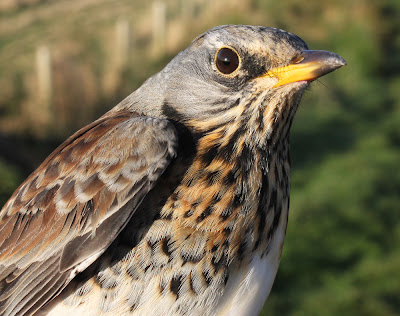Our Fylde Ringing Group totals for October make decent reading. The prolonged wind and rain of September left numbers struggling upwards, but an improvement in October’s weather led to a much healthier looking total of birds ringed during the month, 664 birds of 23 species.
Greenfinches ringed at Fleetwood were the most numerous, with my own efforts out on Rawcliffe Moss directed at both Chaffinches and Goldfinch, and then later in the month Lesser Redpoll and northern thrushes, Redwing and Fieldfare. While Redwing subsequently features in the top ten, the harder to catch Fieldfare does not, with just 4 caught.
Top-Ten totals for October in order of magnitude: Greenfinch (284), Chaffinch (72), Goldfinch (38), Redwing (36), Long-tailed Tit (34), Blackbird (34), Lesser Redpoll 29), Meadow Pipit (29), Coal Tit (16), Song Thrush (16).
From August onwards, I continued with my age/sex analysis of autumn Chaffinches dispersing south and over Rawcliffe Moss. Despite losing many sessions in September, the numbers caught in October redressed the situation somewhat, but the overall total of 181 Chaffinch for the whole of the autumn of 2012 proved way down on figures for the equivalent period in 2010 (332 Chaffinch) and in 2011 (375 Chaffinch).
Chaffinch
Although the actual numbers are lower for 2012 the percentages of each age/sex class are remarkably consistent with the previous two autumns - see chart below. The only inconsistency would seem to be the low percentage of adults (5%) in the September 2012 catches, as compared to 15-18% for the same month in the years 2010/2011. In view of the summer weather during 2012 it might be tempting to explain the low number as adults extending their breeding and moult cycle by a number of weeks and hence a delay in leaving home ranges. More likely it will remain as an unsolved variance or a blip cause by the lower sample.
Table: Age/Sex ratios of Chaffinches
Out Rawcliffe, Aug to Oct 2010-2012
Month
|
Total Captures
|
Adults (% of Total Captures)
|
1CYs (% of Total Captures)
|
1CY male (% of 1CYs)
|
1CY female (% of 1CYs)
|
Aug 2010
|
27
|
9 (33%)
|
18 (67%)
|
5 (28%)
|
13 (72%)
|
Aug 2011
|
44
|
5 (11%)
|
39 (89%)
|
17 (43%)
|
22 (57%)
|
Aug 2012
|
37
|
5 (13%)
|
32 (87%)
|
14 (59%)
|
13 (41%)
|
Sep 2010
|
263
|
48 (18%)
|
215 (82%)
|
71 (33%)
|
144 (67%)
|
Sep 2011
|
228
|
35 (15%)
|
193 (85%)
|
88 (45%)
|
105 (55%)
|
Sep 2012
|
84
|
4 (5%)
|
80 (95%)
|
35 (44%)
|
45 (56%)
|
Oct 2010
|
42
|
16 (38%)
|
26 (62%)
|
8 (31%)
|
18 (69%)
|
Oct 2011
|
103
|
17 (17%)
|
86 (83%)
|
37 (43%)
|
49 (57%)
|
Oct 2012
|
42
|
16 (38%)
|
26 (62%)
|
8 (31%)
|
18 (69%)
|
In all a total of 888 Chaffinches were captured throughout the three month period of each year 2010 to 2012 inclusive. Adults made up between 5% and 38% of a catch during any month, with an average of 20%
Of 888 Chaffinch in the three years, first year birds made up between 62% and 95% of the catches in any month, the actual average being 80%.
First year males comprised between 28% and 49% of first year birds, the average being 42%.
First year females made up between 41% and 72% of first year birds, the average being 58%.
The figures above correspond to the information in The British Trust for Ornothology Migration Atlas which states "Chaffinches involved in autumnal movements are thought to be 90% first year birds, predominantly females".
The figures above correspond to the information in The British Trust for Ornothology Migration Atlas which states "Chaffinches involved in autumnal movements are thought to be 90% first year birds, predominantly females".
There is one outstanding “controlled” Chaffinch yet to be notified, an adult female Y867191 caught on 21st October. Many years of ringing Chaffinches shows that most if not all of this region’s autumnal Chaffinch originate from the Northern Pennines, SW Scotalnd and The English Lake District, so it will be interesting to see if this record follows the same pattern.
Chaffinch
Another Bird Blog is indoors today, waiting for BT to bring a replacement router because my Internet connection has been off and on like a politician's grin. Hopefully the fix will be permanent, so keep looking in for the latest update soon.











































.jpeg)



.jpg)













